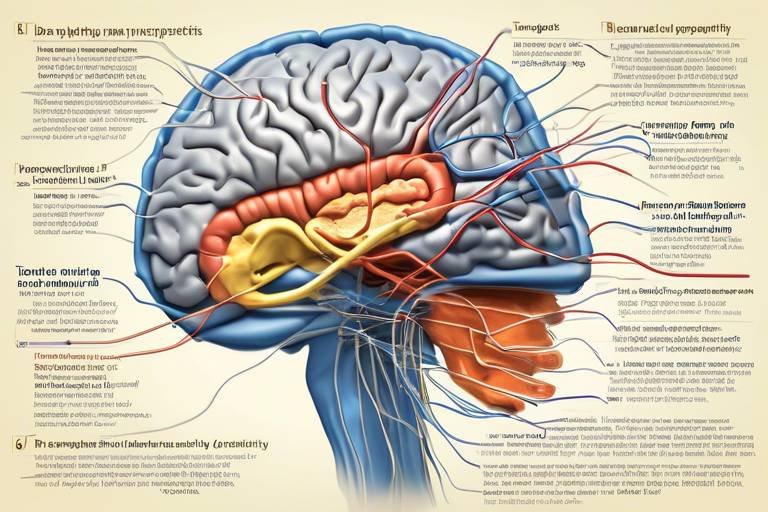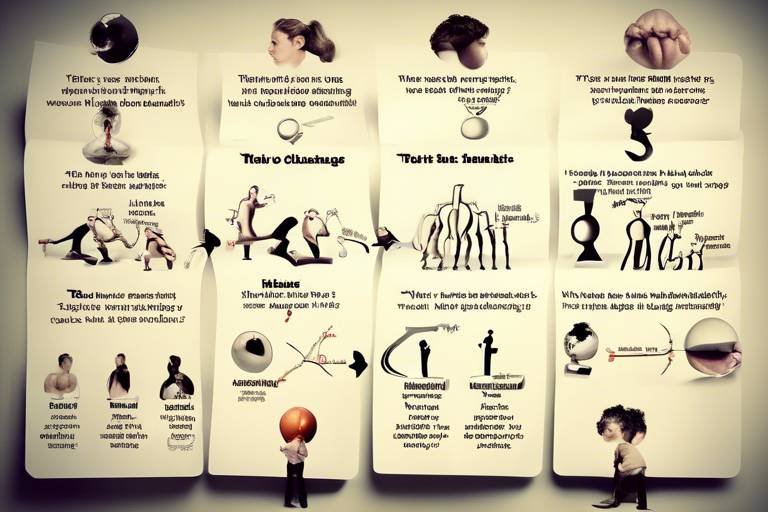How Different Cultures Approach Health - The Science of Diversity
In our ever-globalizing world, understanding how different cultures approach health is not just fascinating; it's essential. The ways in which societies interpret health, illness, and wellness are as diverse as the cultures themselves. From the herbal remedies of indigenous tribes to the structured practices of modern medicine, each culture brings its unique perspective to the table. This diversity not only enriches our understanding of health but also highlights the intricate relationship between culture and health outcomes.
Imagine walking into a bustling marketplace in India, where the air is filled with the aroma of spices and herbs. Here, health is often viewed through the lens of Ayurveda, an ancient system that emphasizes balance within the body and mind. In stark contrast, a visit to a hospital in the United States might present a more clinical approach, focused on symptoms and treatments rather than holistic well-being. This juxtaposition illustrates the profound impact cultural beliefs have on health practices.
At the heart of these cultural perspectives is the understanding that health is not merely the absence of disease but a state of complete physical, mental, and social well-being. Different cultures define wellness in various ways, influenced by historical, social, and environmental factors. For instance, in many African communities, health is seen as a communal responsibility, where social ties and support systems play a crucial role. On the other hand, individualism in Western cultures often leads to a more personal approach to health, focusing on individual choices and medical interventions.
Moreover, the integration of traditional practices into modern healthcare systems is becoming increasingly prominent. Many people worldwide are turning to alternative therapies, recognizing the value of traditional medicine alongside conventional treatments. This blending of practices not only honors cultural heritage but also enhances the overall effectiveness of health care by providing patients with a more comprehensive approach to their well-being.
In this article, we will explore the rich tapestry of health practices across cultures, examining how beliefs, traditions, and social influences shape health outcomes and healthcare systems worldwide. From the herbal remedies that have stood the test of time to the modern healthcare systems that strive for inclusivity, the science of diversity in health is a captivating journey that reveals much about humanity itself.
Cultural perspectives significantly influence how individuals perceive health, illness, and wellness. This section delves into the foundational beliefs that shape these perspectives across various societies.
Various cultures rely on traditional medicine systems, which include herbal remedies, rituals, and holistic approaches. This section examines the role of these practices in promoting health and treating illnesses.
Herbal remedies are integral to many cultures' health practices. This subsection highlights specific herbs used across cultures and their perceived benefits for physical and mental well-being.
Indigenous healing practices often incorporate spirituality and community. This section discusses how these elements contribute to the effectiveness of healing within indigenous cultures.
Ayurveda and Traditional Chinese Medicine offer comprehensive health systems based on ancient philosophies. This section explores their principles and how they differ from Western medicine.
Modern healthcare systems vary globally, influenced by cultural, economic, and political factors. This section analyzes the strengths and weaknesses of different healthcare models and their accessibility.
Cultural barriers can hinder individuals' access to healthcare services. This section examines common obstacles, including language, stigma, and differing health beliefs, that affect healthcare utilization.
Language barriers can significantly impact patient-provider communication. This subsection discusses how miscommunication can lead to misunderstandings and affect health outcomes.
Mental health stigma varies across cultures and can deter individuals from seeking help. This section explores how cultural attitudes toward mental health influence treatment and support systems.
Community plays a vital role in shaping health behaviors and outcomes. This section highlights how social support networks and cultural practices contribute to overall well-being and health promotion.
- What are some common traditional medicine practices?
Traditional medicine practices vary widely across cultures, including herbal remedies, acupuncture, and spiritual healing. - How does culture influence health outcomes?
Cultural beliefs shape perceptions of health and illness, affecting how communities respond to healthcare services and treatments. - What role does community play in health?
Community provides social support and shared practices that can enhance individual well-being and promote healthier lifestyles.

Understanding Cultural Perspectives on Health
Cultural perspectives significantly influence how individuals perceive health, illness, and wellness. Each culture has its own unique set of beliefs and traditions that shape health practices and attitudes. For instance, in many Western societies, health is often viewed through a biomedical lens, focusing on physical symptoms and medical interventions. However, in other cultures, health might be seen as a holistic balance between the body, mind, and spirit. This divergence in understanding can lead to vastly different approaches to treatment and prevention.
To truly appreciate the diversity in health perspectives, we must consider several foundational beliefs that vary across societies. In some cultures, health is deeply intertwined with spirituality. For example, Indigenous cultures often view health as a connection to the land and community. This perspective emphasizes the importance of social relationships and the environment in maintaining well-being. In contrast, many modern societies prioritize individualism, often leading to a more isolated approach to health management.
Another critical aspect is how cultures define illness. In some traditions, illnesses may be seen as a punishment from a higher power or a disruption of spiritual harmony. This belief can significantly affect how individuals seek treatment and perceive healthcare providers. For example, if someone believes that their illness is a result of spiritual imbalance, they may turn to traditional healers rather than conventional medical practitioners.
Furthermore, the role of family and community in healthcare cannot be overstated. In collectivist cultures, family members often play an active role in health decisions, providing emotional support and care for the sick. This community involvement contrasts sharply with more individualistic cultures, where personal choice and autonomy are highly valued. Understanding these cultural contexts is essential for healthcare providers who aim to deliver effective and respectful care.
As we navigate through these diverse cultural perspectives, it's essential to recognize that no single approach is superior. Instead, the integration of various health beliefs and practices can lead to a more comprehensive understanding of health. By embracing this diversity, we can foster a more inclusive healthcare system that respects and values the unique experiences of individuals from all walks of life.

Traditional Medicine Practices
When we think about health, it's easy to get caught up in the shiny world of modern medicine, complete with its high-tech gadgets and quick fixes. However, traditional medicine practices have been the backbone of health and wellness for countless cultures around the globe. These practices are not merely relics of the past; they represent a rich tapestry of knowledge, beliefs, and rituals that have evolved over centuries. From herbal remedies to spiritual healing, traditional medicine offers a unique lens through which we can understand health.
At the heart of traditional medicine is the concept of holistic care. Unlike the often compartmentalized approach of Western medicine, many traditional practices view health as a balance between the body, mind, and spirit. This holistic perspective is evident in various systems, such as Ayurveda from India and Traditional Chinese Medicine (TCM), where the focus is not just on treating symptoms but on nurturing overall well-being. These systems often employ a combination of herbal remedies, dietary adjustments, and lifestyle changes to restore harmony and promote health.
For instance, consider the use of herbal remedies. Across different cultures, certain herbs are revered for their healing properties. In Ayurveda, turmeric is celebrated not only for its anti-inflammatory benefits but also for its role in detoxification and digestion. Similarly, in TCM, ginseng is often used to boost energy and enhance immunity. The belief in the power of these natural substances highlights a fundamental principle in traditional medicine: the idea that nature provides the tools we need for healing.
Herbal remedies are a cornerstone of traditional medicine practices, and their usage varies widely across cultures. In Africa, for example, plants like baobab and moringa are not just food sources; they're also considered vital for their nutritional and medicinal properties. Meanwhile, in South America, indigenous tribes utilize plants like ayahuasca for spiritual and physical healing, showcasing a profound connection between nature and health.
Incorporating these herbal remedies into daily life is often seen as a way to prevent illness rather than just treating it. This preventive approach is a significant departure from many modern healthcare systems, which frequently focus on reactive treatments. By understanding and respecting the wisdom embedded in these traditional practices, we can learn valuable lessons about health and wellness.
Indigenous healing practices take the integration of spirituality and community to a whole new level. In many indigenous cultures, health is viewed as a collective responsibility, deeply intertwined with the community's well-being. Healing rituals often involve not just the individual but also family members and the community at large. This collective approach fosters a sense of belonging and support, which is crucial for the healing process. For instance, in Native American cultures, healing ceremonies often incorporate music, dance, and storytelling, creating a rich environment for emotional and spiritual healing.
Both Ayurveda and TCM are ancient systems that have stood the test of time, offering comprehensive frameworks for health. Ayurveda emphasizes the balance of three doshas (Vata, Pitta, and Kapha) and employs various therapies, including yoga and meditation, to achieve this balance. On the other hand, TCM focuses on the flow of Qi (life energy) and aims to harmonize the body's energies through acupuncture, herbal medicine, and dietary therapy. While both systems share a holistic view of health, they differ in their philosophies and methodologies, showcasing the diversity of traditional medicine practices around the world.
In conclusion, traditional medicine practices are not just historical artifacts; they are living systems of knowledge that offer valuable insights into health and wellness. By exploring these practices, we can appreciate the profound ways in which culture shapes our understanding of health and healing.

Herbal Remedies in Different Cultures
Herbal remedies have been a cornerstone of health practices across the globe, deeply rooted in the traditions and beliefs of various cultures. From the lush rainforests of the Amazon to the arid landscapes of the Middle East, people have turned to nature for healing long before the advent of modern medicine. These remedies are often seen as not just treatments, but as holistic approaches that connect the body, mind, and spirit. So, what makes these herbal practices so unique? Let's dive into some fascinating examples.
One of the most well-known herbal traditions is found in Traditional Chinese Medicine (TCM). Here, herbs are not merely ingredients; they are part of a larger system that includes acupuncture and dietary therapy. For instance, Ginseng is revered for its ability to boost energy and enhance overall vitality. Similarly, Gingko Biloba is commonly used to improve memory and cognitive function. The philosophy behind TCM emphasizes balance and harmony within the body, suggesting that health is not just the absence of disease but a state of equilibrium.
In contrast, Ayurveda, an ancient healing system from India, focuses on the concept of doshas—three energies believed to govern our physical and mental processes. Herbs like Tulsi (Holy Basil) and Turmeric play significant roles in Ayurvedic practices. Tulsi is known for its adaptogenic properties, helping the body cope with stress, while Turmeric is celebrated for its anti-inflammatory benefits. The use of these herbs is often personalized, considering the individual's unique constitution and lifestyle.
Moving to the Americas, indigenous cultures have long utilized local plants for medicinal purposes. For example, the Willow tree has been used by Native Americans to alleviate pain and inflammation. Its bark contains salicin, a natural compound that inspired the development of modern pain relievers like aspirin. This showcases how traditional knowledge often aligns with contemporary scientific discoveries, bridging the gap between ancient wisdom and modern medicine.
The beauty of herbal remedies lies not just in their effectiveness but also in the stories and cultural significance behind them. In many cultures, the preparation and consumption of herbal remedies are communal activities, fostering a sense of belonging and shared knowledge. Whether it's gathering herbs in the wild or preparing a family recipe passed down through generations, these practices create bonds that strengthen community ties.
However, it's essential to recognize that while herbal remedies can be beneficial, they are not without their risks. Some herbs can interact with conventional medications or may not be suitable for everyone. Therefore, it's crucial for individuals to seek guidance from knowledgeable practitioners when incorporating herbal remedies into their health regimen.
As we explore the world of herbal remedies, it becomes clear that these practices are more than just treatments; they are a testament to the rich tapestry of human experience and the diverse ways we seek health and wellness. The next time you sip on a cup of herbal tea or take a herbal supplement, remember that you are participating in a tradition that spans centuries and cultures, connecting you to a larger narrative of healing and hope.
- What are herbal remedies? Herbal remedies are natural treatments derived from plants used for healing and health maintenance.
- Are herbal remedies safe? While many are safe, some can interact with medications or may not be suitable for everyone. Consulting a healthcare provider is recommended.
- How do I know which herbal remedy to use? It's best to consult with a knowledgeable practitioner who can guide you based on your individual health needs and conditions.
- Can herbal remedies replace traditional medicine? Herbal remedies can complement traditional treatments, but they should not replace professional medical advice or treatment.

Indigenous Healing Practices
Indigenous healing practices are a fascinating blend of spirituality, community involvement, and a deep connection to nature. These practices are not just about treating physical ailments; they encompass a holistic approach that considers the emotional, spiritual, and social aspects of health. In many indigenous cultures, health is seen as a balance between these elements, and when one is out of sync, it can lead to illness. This perspective is a stark contrast to the often compartmentalized approach of Western medicine.
At the core of indigenous healing is the belief that the body, mind, and spirit are interconnected. Healers, often referred to as shamans or medicine people, play a crucial role in this process. They are not only knowledgeable about herbal remedies and natural treatments but are also seen as spiritual guides. Their role is to facilitate healing by addressing the underlying causes of illness, which may include emotional trauma, spiritual disconnection, or environmental factors.
One of the key components of indigenous healing is the use of ceremonies and rituals. These practices are designed to restore balance and harmony within an individual and their community. For instance, a healing circle may be held where individuals share their experiences and support one another, reinforcing community bonds. Such gatherings are essential as they provide a safe space for individuals to express their feelings and seek guidance.
Moreover, herbal medicine plays a significant role in indigenous healing practices. Many indigenous cultures have extensive knowledge of local plants and their medicinal properties. For example:
- White Sage: Used for purification and cleansing rituals.
- Echinacea: Known for its immune-boosting properties.
- Willow Bark: Often used as a natural pain reliever.
These herbs are not only used for their physical healing properties but also for their spiritual significance. The act of gathering these plants can be seen as a ritual itself, connecting the healer to the land and their ancestors.
Furthermore, the importance of community cannot be overstated. In indigenous cultures, healing is often a communal effort. The support of family and community members is vital for an individual’s recovery. This collective approach fosters a sense of belonging and reduces feelings of isolation, which can be detrimental to one’s health. By engaging the community, indigenous healing practices create a network of support that enhances the overall healing process.
In conclusion, indigenous healing practices offer a rich tapestry of methods that emphasize the interconnectedness of body, mind, and spirit. By integrating spirituality, community, and natural remedies, these practices provide a unique perspective on health and wellness that is often overlooked in modern healthcare systems. As we continue to explore these diverse approaches, it’s essential to recognize and respect the wisdom that indigenous cultures have to offer.
What are indigenous healing practices?
Indigenous healing practices refer to the traditional methods used by indigenous cultures to promote health and wellness. These practices often involve a holistic approach that includes physical, emotional, and spiritual healing through rituals, community support, and the use of natural remedies.
How do community and spirituality influence indigenous healing?
Community and spirituality are central to indigenous healing. Healing is often viewed as a communal effort, where family and community members support the individual. Spirituality plays a role in understanding the causes of illness and in the healing rituals that restore balance and harmony.
What role do herbs play in indigenous healing?
Herbs are a vital component of indigenous healing practices. Indigenous cultures possess extensive knowledge of local plants and their medicinal properties, using them not just for physical ailments but also for their spiritual significance.

Ayurveda and Traditional Chinese Medicine
When we think of health systems, Ayurveda and Traditional Chinese Medicine (TCM) often come to mind as two of the most intricate and holistic approaches to wellness. Both systems have stood the test of time, each offering unique insights into the balance of body, mind, and spirit. But what sets them apart? Let's dive into their core principles and philosophies.
Ayurveda, which originated in India over 3,000 years ago, is built upon the idea of balance among the body's three doshas: Vata, Kapha, and Pitta. These doshas represent different energies that govern our physical and mental characteristics. The goal of Ayurveda is to maintain or restore balance through a personalized approach that includes diet, lifestyle changes, and herbal treatments. For example, someone with a predominance of Vata may be advised to consume warm, nourishing foods to counteract their natural coolness and dryness.
On the other hand, TCM, which dates back thousands of years in China, revolves around the concept of Qi (pronounced "chee"), the vital life force that flows through our bodies. TCM practitioners believe that health is achieved when Qi is balanced and flows freely through meridians, or energy pathways. Techniques such as acupuncture, herbal medicine, and tai chi are employed to enhance this flow. For instance, if someone experiences chronic fatigue, a TCM practitioner might use acupuncture to stimulate specific points, thereby restoring energy balance.
| Aspect | Ayurveda | Traditional Chinese Medicine |
|---|---|---|
| Origin | India | China |
| Core Concept | Balance of doshas | Balance of Qi |
| Treatment Methods | Herbs, diet, lifestyle | Acupuncture, herbal medicine, tai chi |
| Focus | Individual constitution | Energy pathways |
While both Ayurveda and TCM emphasize the importance of a holistic approach, they also acknowledge the significance of the individual. Ayurveda tailors its practices to the unique constitution of each person, whereas TCM focuses on the flow of energy and its relationship to the environment. This adaptability is crucial, as it allows practitioners to address a wide range of health issues, from chronic illnesses to acute conditions.
Interestingly, both systems also share a common understanding of the interconnectedness of the body and mind. They recognize that emotional and mental states can significantly influence physical health. For example, stress and anxiety can manifest as digestive issues in Ayurveda, while TCM might associate these feelings with blockages in Qi flow. This shared perspective highlights the importance of treating the whole person rather than just the symptoms.
In conclusion, while Ayurveda and Traditional Chinese Medicine may differ in their methodologies and terminologies, they both offer invaluable insights into health and wellness. By embracing the principles of these ancient practices, individuals can cultivate a deeper understanding of their health and well-being, ultimately leading to a more balanced and fulfilling life.

Modern Healthcare Systems
When we talk about , we're diving into a complex web of practices, policies, and beliefs that shape how we receive medical care today. These systems are not just about hospitals and doctors; they are influenced by a myriad of factors, including cultural, economic, and political elements. For instance, in some countries, healthcare is considered a fundamental right, while in others, it is viewed as a commodity. This fundamental difference can lead to stark contrasts in accessibility and quality of care across the globe.
In many developed nations, the healthcare system is often characterized by a mix of public and private services. Countries like the United States have a predominantly private healthcare model, where individuals often rely on insurance companies to cover medical expenses. However, this can lead to significant disparities in access to care, especially for those without insurance. On the other hand, countries like Canada and the UK operate under a public healthcare system, where the government funds healthcare services, aiming to provide equal access to all citizens.
To better understand the differences in modern healthcare systems, let's take a look at some key characteristics:
| Country | Healthcare Model | Accessibility | Funding Source |
|---|---|---|---|
| United States | Predominantly Private | Varied, often dependent on insurance | Insurance premiums, out-of-pocket payments |
| Canada | Publicly Funded | Universal for citizens | Tax-funded |
| United Kingdom | Publicly Funded (NHS) | Universal for citizens | Tax-funded |
| Germany | Social Health Insurance | Universal, with private options | Insurance premiums, employer contributions |
As we can see from the table, the way healthcare is structured can greatly impact health outcomes. For example, in countries with universal healthcare, preventive services tend to be more accessible, which can lead to better health outcomes overall. In contrast, in systems dominated by private care, many individuals may delay seeking treatment due to costs, leading to more severe health issues down the line.
Moreover, the integration of technology in modern healthcare systems has revolutionized how we approach health. Telemedicine, electronic health records, and AI-driven diagnostics are just a few examples of how technology is enhancing patient care and making healthcare more efficient. However, this technological advancement also raises questions about data privacy and the digital divide, particularly in less developed regions where access to technology may be limited.
In conclusion, while modern healthcare systems aim to provide care, the effectiveness and accessibility of these systems vary greatly depending on cultural, economic, and political contexts. Understanding these differences is crucial for anyone looking to navigate the global healthcare landscape, whether as a patient, a provider, or a policymaker.
- What is the main difference between public and private healthcare systems?
Public healthcare systems are funded by the government and aim to provide universal access, while private healthcare systems are funded through insurance and out-of-pocket payments, often leading to disparities in access. - How does technology impact modern healthcare?
Technology improves efficiency and patient care through telemedicine and electronic health records but also raises issues regarding data privacy and access to technology. - Why are healthcare outcomes better in some countries?
Countries with universal healthcare often have better preventive care access, leading to improved health outcomes compared to those reliant on private insurance.

Cultural Barriers to Healthcare Access
Cultural barriers can significantly hinder individuals' access to healthcare services. These barriers often stem from deeply ingrained beliefs, social norms, and communication challenges that vary from one culture to another. Imagine trying to navigate a maze where each turn is influenced by a different set of rules; that's how many people feel when seeking healthcare in a culturally unfamiliar environment. For instance, individuals from cultures that prioritize family decision-making may struggle in systems that emphasize individual autonomy. This disconnect can lead to confusion and frustration, ultimately affecting their willingness to seek care.
One of the most pressing issues is the language barrier. When patients cannot communicate effectively with their healthcare providers, it can lead to misunderstandings regarding symptoms, diagnoses, and treatment plans. A study found that nearly 25% of non-English speakers reported not receiving necessary medical care due to language difficulties. This statistic underscores the importance of having multilingual staff and translation services in healthcare settings. Furthermore, when patients feel that their concerns are not understood, they may become disengaged from the healthcare process altogether.
Another significant barrier is the stigma surrounding certain health conditions, particularly mental health issues. In many cultures, mental health is viewed through a lens of shame or weakness, which can deter individuals from seeking help. For example, in some communities, expressing struggles with mental health can lead to social ostracization. This stigma can create a vicious cycle where individuals suffer in silence, exacerbating their conditions while avoiding the very support they need. Addressing this stigma requires a cultural shift that promotes understanding and acceptance of mental health as a vital component of overall well-being.
Additionally, differing health beliefs can complicate access to care. In some cultures, traditional healing practices are preferred over conventional medicine. Patients may prioritize herbal remedies or spiritual healing, viewing them as more effective than Western medical practices. This preference can lead to a reluctance to engage with healthcare systems that are perceived as foreign or untrustworthy. Therefore, healthcare providers must recognize and respect these beliefs while finding ways to integrate them into treatment plans. For instance, a patient who believes in the power of herbal medicine might be more receptive to a treatment that combines both herbal and conventional approaches.
To effectively address these cultural barriers, healthcare systems must adopt a more inclusive and understanding approach. This could involve training healthcare professionals in cultural competence, ensuring that they are aware of the diverse backgrounds of their patients and the unique challenges they may face. Moreover, creating community outreach programs that educate individuals about available healthcare services can bridge the gap between cultural beliefs and medical practices. By fostering an environment of trust and respect, healthcare providers can encourage more individuals to seek the care they need without fear of judgment or misunderstanding.
- What are cultural barriers in healthcare? Cultural barriers in healthcare refer to the obstacles that arise from differing beliefs, values, and practices that affect how individuals access and engage with healthcare services.
- How can language barriers impact healthcare access? Language barriers can lead to miscommunication between patients and providers, resulting in misunderstandings about symptoms, diagnoses, and treatment plans, ultimately hindering access to necessary care.
- Why is there stigma surrounding mental health in some cultures? Stigma surrounding mental health often stems from cultural beliefs that associate mental illness with weakness or shame, deterring individuals from seeking help and support.
- How can healthcare providers address cultural barriers? Healthcare providers can address cultural barriers by receiving training in cultural competence, offering multilingual services, and integrating traditional healing practices into treatment plans.

Language and Communication Challenges
Language barriers can create significant hurdles in healthcare settings, impacting the quality of care that patients receive. Imagine walking into a doctor's office where the language spoken is completely foreign to you. How would you explain your symptoms? This scenario is a reality for many individuals who face difficulties in communicating their health concerns due to language differences. Effective communication is essential in healthcare, as it not only facilitates accurate diagnosis but also fosters a trusting relationship between patients and healthcare providers.
Miscommunication can lead to misunderstandings, which can exacerbate health issues. For instance, a patient may describe their symptoms incorrectly due to language limitations, resulting in a misdiagnosis. The consequences can be dire, affecting treatment plans and ultimately, patient outcomes. Studies show that patients with limited English proficiency are more likely to experience adverse health outcomes compared to those who can communicate effectively in the dominant language of their healthcare system.
Furthermore, cultural nuances embedded in language can complicate communication even further. Certain phrases or expressions may not have direct translations, leading to confusion. For example, idioms or culturally specific references might not resonate with healthcare providers from different backgrounds. This disconnect can create a barrier to understanding and empathy, making it more challenging for patients to express their needs and for providers to deliver appropriate care.
To combat these challenges, many healthcare systems are beginning to implement strategies aimed at improving communication. Here are some effective approaches:
- Interpreter Services: Many hospitals now offer interpreter services that provide real-time translation for patients and providers, ensuring that both parties can communicate effectively.
- Cultural Competency Training: Healthcare professionals are increasingly being trained in cultural competency, equipping them to better understand and navigate the diverse backgrounds of their patients.
- Patient Education Materials: Providing health information in multiple languages helps empower patients to understand their conditions and treatment options.
In conclusion, addressing language and communication challenges is crucial for enhancing healthcare accessibility and quality. By recognizing these barriers and implementing effective solutions, we can create a more inclusive healthcare environment that respects and accommodates the diverse needs of all patients.
- What are the main challenges posed by language barriers in healthcare?
Language barriers can lead to miscommunication, misunderstandings, and inadequate patient care, impacting diagnosis and treatment. - How can healthcare providers improve communication with patients who speak different languages?
Providers can utilize interpreter services, engage in cultural competency training, and offer educational materials in multiple languages. - Why is cultural competency important in healthcare?
Cultural competency helps healthcare professionals understand the diverse backgrounds of their patients, leading to better communication and improved health outcomes.

Stigma Surrounding Mental Health
The stigma surrounding mental health is a pervasive issue that affects individuals across various cultures, often acting as a barrier to seeking help and receiving adequate support. This stigma can manifest in numerous ways, from negative stereotypes to outright discrimination, making it difficult for those struggling with mental health issues to openly discuss their challenges. Imagine walking through a crowded room, feeling the weight of judgment from those around you; this is the reality for many who face mental health struggles. They often feel isolated, as if they are carrying a burden that no one else can see or understand.
In many cultures, mental health issues are still viewed through a lens of misunderstanding and fear. For instance, in some societies, mental illness is equated with weakness or a lack of willpower, leading to a belief that individuals should simply "toughen up." This perspective can be incredibly damaging, as it not only invalidates the experiences of those suffering but also perpetuates a cycle of silence. People may feel they cannot share their struggles with friends or family for fear of being judged or ostracized. This fear can prevent them from accessing the very help they need, creating a vicious cycle that can worsen their condition.
Moreover, cultural attitudes towards mental health can vary dramatically. In some cultures, discussing mental health openly is taboo, leading to the idea that mental illness is something to be hidden away. For example, in certain communities, mental health issues are often kept within the family, with individuals feeling pressured to maintain a facade of normalcy. This can lead to a lack of understanding and empathy from those who do not experience these challenges firsthand. The resulting silence can be deafening, leaving those in need feeling even more isolated.
It’s important to recognize that stigma can also affect how mental health services are perceived. Many individuals may avoid seeking treatment due to fears of being labeled or judged by healthcare providers. This is particularly concerning when you consider that mental health is just as important as physical health. The reluctance to seek help can lead to untreated mental health conditions, which can have serious implications for overall well-being. In fact, studies have shown that individuals who experience stigma are less likely to utilize mental health services, which can exacerbate their situations.
To combat this stigma, education and awareness are crucial. By fostering open conversations about mental health, we can begin to dismantle the misconceptions that surround it. Community initiatives, such as support groups and mental health awareness campaigns, can play a significant role in changing perceptions. When individuals see others openly discussing their struggles and seeking help, it can create a ripple effect, encouraging more people to do the same. It’s essential to create a safe space where individuals feel comfortable sharing their experiences without fear of judgment.
In conclusion, the stigma surrounding mental health is a complex issue that varies across cultures, but its impact is universally felt. By addressing these cultural attitudes and promoting dialogue, we can help to create a society where mental health is prioritized and individuals feel empowered to seek the help they need. Remember, mental health is not a personal failing; it's a health issue that deserves understanding, compassion, and support.
- What is mental health stigma? Mental health stigma refers to the negative attitudes and beliefs that society holds about people with mental health conditions, often leading to discrimination and exclusion.
- How can we reduce stigma surrounding mental health? Reducing stigma can be achieved through education, open discussions, and community support programs that encourage individuals to share their experiences.
- Why is it important to talk about mental health? Talking about mental health helps to normalize the conversation, reduces feelings of isolation, and encourages those in need to seek help without fear of judgment.

The Role of Community in Health
When we talk about health, we often think of individual choices—like what we eat, how much we exercise, or whether we visit the doctor regularly. However, the truth is that our health is profoundly influenced by the community we belong to. Imagine living in a vibrant neighborhood where everyone looks out for one another; this sense of belonging can significantly enhance our well-being. Communities provide a support system that can help individuals navigate health challenges, share resources, and promote healthy behaviors.
Social support is a critical aspect of health. Studies have shown that individuals with strong social networks tend to have better health outcomes. This is because communities can offer emotional support during tough times, practical help when needed, and a sense of belonging that fosters mental well-being. For instance, when someone is recovering from an illness, having friends and family nearby can make the process feel less daunting. It's like being part of a team where everyone cheers you on, making it easier to overcome obstacles.
Moreover, community health initiatives play a vital role in promoting wellness. Many neighborhoods have local programs aimed at improving health outcomes, such as free fitness classes, health screenings, and nutrition workshops. These initiatives are often tailored to the specific needs of the community, addressing issues like obesity, diabetes, or mental health. By participating in these programs, individuals not only improve their own health but also contribute to a healthier community overall. Think of it as planting seeds; when one person thrives, it encourages others to follow suit.
In addition to formal health initiatives, informal gatherings also foster a culture of health. Community events, such as farmers' markets, health fairs, or neighborhood clean-up days, create opportunities for social interaction and promote healthy lifestyles. These gatherings encourage people to engage with one another, share tips, and inspire healthy habits. When you see your neighbor jogging or gardening, it can motivate you to get moving too. It's the ripple effect of community engagement!
However, not all communities have equal access to health resources. Disparities in healthcare access can create significant barriers, leading to poorer health outcomes for some groups. For example, low-income neighborhoods may lack grocery stores that sell fresh produce, or they may have limited access to healthcare facilities. This highlights the importance of advocating for equitable health resources within communities. When we work together to address these disparities, we can create environments where everyone has the opportunity to thrive.
In summary, the role of community in health is profound and multifaceted. From providing emotional support to promoting healthy behaviors and advocating for equitable resources, communities are essential for our overall well-being. So, the next time you think about your health, consider the community around you. How can you contribute to making it a healthier place? After all, we are all in this together!
- How does community support affect mental health?
Community support can significantly reduce feelings of isolation and loneliness, which are common contributors to mental health issues. Having a network of friends and family can provide emotional stability and encourage individuals to seek help when needed. - What are some examples of community health initiatives?
Examples include health fairs, vaccination drives, fitness programs, and nutrition workshops. These initiatives often focus on specific health issues prevalent in the community. - How can I get involved in my community's health initiatives?
Start by reaching out to local health organizations, community centers, or volunteer groups. Participating in events or offering your skills can make a significant impact.
Frequently Asked Questions
- What are some common cultural beliefs about health?
Different cultures have unique beliefs that shape their understanding of health. For instance, some cultures view health as a balance between physical, mental, and spiritual well-being, while others may emphasize the importance of community and family support in maintaining health. These perspectives can influence how individuals approach illness, wellness, and healthcare.
- How do traditional medicine practices vary across cultures?
Traditional medicine practices differ significantly around the world. In many cultures, herbal remedies and holistic approaches are prevalent. For example, Ayurveda from India focuses on balance and natural healing, while Traditional Chinese Medicine emphasizes harmony within the body. Each system has its own set of practices and beliefs that guide treatment and promote health.
- What role do community and social support play in health?
Community and social support are crucial for health outcomes. Strong social networks can provide emotional support, practical help, and shared resources, which can enhance individual well-being. In many cultures, communal activities and traditions foster a sense of belonging and promote healthier lifestyles, making community a vital component of overall health.
- What are some barriers to accessing healthcare in different cultures?
Cultural barriers to healthcare access can include language differences, stigma surrounding certain health conditions, and varying beliefs about health and illness. These obstacles can lead to misunderstandings between patients and healthcare providers, ultimately affecting the quality of care received. Addressing these barriers is essential for improving healthcare access and outcomes.
- How does stigma affect mental health treatment in various cultures?
Stigma surrounding mental health can vary widely across cultures. In some societies, mental health issues are highly stigmatized, leading individuals to avoid seeking help due to fear of judgment. This can create significant barriers to treatment and support. Understanding the cultural context of mental health is essential for developing effective intervention strategies that encourage individuals to seek help.
- What is the impact of language barriers on healthcare?
Language barriers can significantly hinder effective communication between patients and healthcare providers. Misunderstandings can occur, leading to incorrect diagnoses, inappropriate treatments, or even non-compliance with medical advice. Ensuring that patients have access to interpreters or bilingual healthcare professionals can help bridge this gap and improve health outcomes.



















